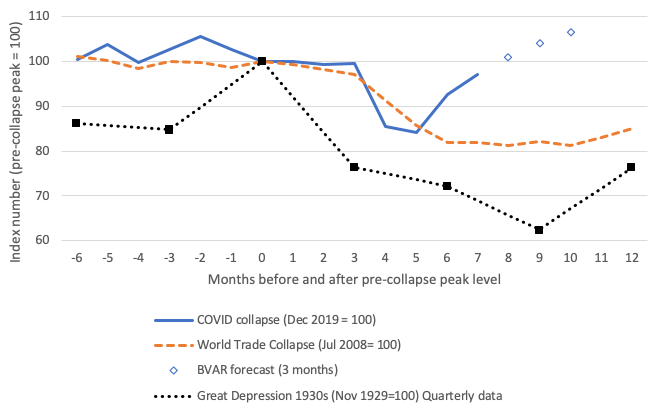The impact of Covid-19 on world trade is a cause for grave concern to international policymakers (Wolff 2020). Projections for the contraction of the annual volume of world trade in 2020 range from -10% to -32% (Figure 1).
Initially, the fall in world trade was exceptionally strong. However, recovery has set in early in comparison to the two major historical episodes of trade collapse (during the Great Recession and the Great Depression) (Eichengreen and O’Rourke 2010, De Grauwe and Yi 2020). This suggests that world trade is more strongly resilient than first anticipated by the various international organisations.
Figure 1 Forecasts for real world trade growth in 2020
Note: O = Optimistic scenario, P = Pessimistic Scenario
Figure 2 compares the developments in world merchandise trade volume, starting six months before the pre-collapse peak that we use to identify period ‘zero’. Both contractions start to ‘bite’ after a quarter, but in the fourth month of the coronavirus collapse, world trade was already 17% below the previous peak level (while it was ‘only’ 6% lower at this stage during the 2008/2009 world trade collapse). Global merchandise trade in May 2020, however, bottoms out, and a recovery sets in with a rebound of 7.9% in June and a further 4.8% in July. Further, our Bayesian VAR (BVAR) forecast suggests that the recovery will be sustained and strengthened over the third quarter of 2020.
Figure 2 Comparing the COVID collapse to the 2008/9 world trade collapse and the Great Depression
Sources: Eichengreen, and O’Rourke (2009) and CPB World Trade Monitor July
‘Nowcasting’ with BVAR model during sharp shocks
The key data source for our assessment is the CPB World Trade Monitor, which aggregates worldwide monthly data on merchandise trade for a sample of 81 countries that together account for 99% of world trade (Ebregt 2020).1 The World Trade Monitor reports data within two months, meaning that the time series that we use ends in July 2020. In order to forecast another three months, we use a Bayesian VAR model (De Wind 2015). In addition to incorporating the trade price and volume data used for the construction of the World Trade Measure, the BVAR model incorporates data on industrial production and retail, as well as a selection of leading indicators (such as the CESifo purchasing managers’ index, MSCI world, and the Baltic Dry). In our experience, the BVAR outperforms ‘nowcasting’ based on data science techniques (lasso, random forest, or support vector regression) during periods of significant and fast changes. This is because, in such a period, the data-generating process changes and machine learning does not pick up changes on the basis of training data. In other words, machine learning is based on past patterns that do not include a sudden and significant change. The BVAR does somewhat better and is relatively more sensitive to recent changes (although we stress the words “somewhat” and “relative”). With that caveat in mind, the BVAR indicates that world trade at the time of writing is close to the pre-pandemic level.
Heterogeneity
Historically, many heterogeneities underly the world average during an episode of world trade collapse. During the Great Depression and Great Recession, the synchronisation of national contractions at the start of the trade collapse reflected a common trigger. However, regional differences occurred in both the severity and timing of the collapse and the recovery and diverging developments were also observed with respect to imports versus exports (van Bergeijk 2019). The Covid-19 trade collapse follows a staggered pattern, reflecting the shifting geographical centre of pandemic: the collapse starts in Asia, moves via Europe, and then to the US and Latin America (van Bergeijk 2020). The downfall for the advanced economies starts later, the collapse is deeper, and the turn-around occurs at shorter notice (Figure 3). Emerging economy exports have recovered to pre-pandemic levels over the subsequent three months. Advanced economies are expected to recover more gradually but could recover to pre-pandemic levels in the next three months according to our BVAR model.
Figure 3 Exports and imports for advanced economies (AE) and emerging economies (EE)
(Index numbers, December 2019 =100)
Tables 1 and 2 give a more detailed regional breakdown of the downturn period for exports and imports, respectively. For all country groupings, the length of the current downturn is shorter than during the 2008/2009 world trade collapse.
Table 1 Exports during the downturn (percentage change and duration of the collapse)
Table 2 Imports during the downturn (percentage change and duration of the collapse)
Conclusions
The Covid-19 pandemic has led to an unprecedented global shock, with large hits to trade in almost every country. The good news is that the drop in international merchandise trade, often a leading indicator, appears to follow a sharp ‘V-shaped’ pattern, with a much faster recovery than following earlier episodes of world trade contractions. It is important to note that our analysis applies to merchandise trade only. Recovery of services (including international travel and tourism) will need substantially longer and will require breakthroughs in the treatment of, and protection against, the virus. The resilience of world merchandise trade is remarkable and may reflect the very different underlying factors of the Covid-19 collapse. It is the first encouraging economic news after a long period of ever-increasing sobering assessments of the world economy.
References
van Bergeijk, P A G (2019), Deglobalization 2.0: Trade and Openness During the Great Depression and the Great Recession, Edward Elgar: Cheltenham.
van Bergeijk, P A G (2020), Pandemic Economics, Edward Elgar, in print.
Ebregt, J (2020), “The CPB World Trade Monitor: Technical description (update)”, CPB Netherlands Bureau for Economic Policy Analysis.
Eichengreen, B and K H O’Rourke (2010), “A tale of two depressions”, VoxEU.org, 08 March.
de Grauwe, P and Y Ji (2020), “A tale of three depressions”, VoxEU.org, 24 September. Available at:
de Wind, J (2015), “Technical background document for BVAR models used at CPB”, CPB Netherlands Bureau for Economic Policy Analysis.
Wolff, A W (2020), “COVID-19 and the future of world trade”, VoxEU.org, 01 June.
Endnotes
1 CPB publishes the World Trade Monitor every month on behalf of the European Commission.











